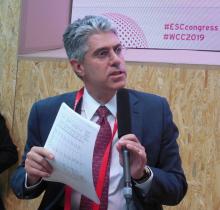However, other experts see an important difference in the risk faced by patients who reach the ESC’s recommended treatment goals and those who fall just short.
“It’s hard to lower an LDL-cholesterol that is already relatively low. People who are close to their cholesterol target need the most intensified treatment” to reach their goal, said Rory Collins, F.Med.Sci., professor of epidemiology at Oxford University. He was not on the ESC guidelines panel.
“It’s a mind shift that clinicians need to be most aggressive in treating patients with the highest risk” even when their LDL-cholesterol is low but not yet at the target level, Dr. Collins said during a discussion session at the congress.
The new ESC guidelines is about “both getting the LDL-cholesterol down to a certain level and also about achieving a big [at least 50%] change” from baseline. “I think the ESC guidelines make that crystal clear,” said Marc S. Sabatine, MD, professor of medicine at Harvard Medical School, Boston, and the sole American to participate in the ESC guidelines-writing panel.
The ESC also broke new ground by advocating an aggressive path toward achieving these LDL-cholesterol goals by elevating the newest and most potent class of approved LDL-cholesterol-lowering drugs, the PCSK9 (proprotein convertase subtilisin/kexin type 9) inhibitors, to a top-tier, class I recommendation (“is recommended”) for secondary prevention in very-high-risk patients not reaching their goal LDL-cholesterol level on a maximally tolerated statin plus ezetimibe. This recommendation to unequivocally add a PCSK9 inhibitor for this patient population contrasts with the 2018 AHA/ACC guideline that deemed adding a PCSK9 inhibitor a IIa recommendation (“is reasonable”).



